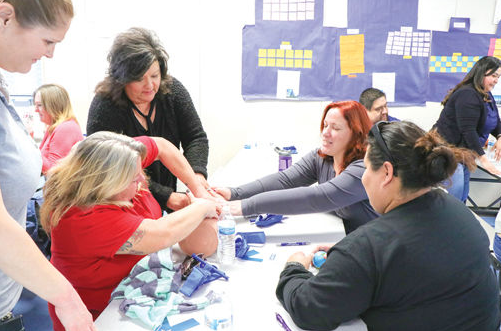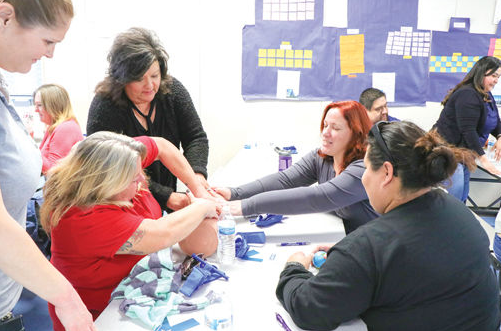Stop The Bleed Training

NEEDLES — Stop the Bleed, a registered trademark of the United States Department of Defense, trains people to be better prepared to save lives if people nearby are severely bleeding.
In the Tri-state area, Stop The Bleed has been taught on 25 campuses and last week, the training was held at the Needles School campus cafeteria.
“We have three more training sessions over the next couple of Fridays and we have hit every school in the area,” said Lynn Lozada of CareFlight/Air Methods, an air ambulance program. “We wanted to bring bleeding control kits to every single school because, in the event of a mass casualty situation or shooting, we go on lockdown. So if somebody is shot they’re going sit in that classroom until the police have told us that EMS can enter and render aid. So those first 10 to 45 minutes, the chances of that person surviving rely on the people in the classroom that are trained. That’s why we are here training you because you are the immediate responders.”
Raymond Proa, of the Fort Mojave Mesa Fire Department, said that three of the big things they teach are how to apply a tourniquet, how to apply direct pressure and wound packing, and to be aware of where you are and how many people require medical assistance.
The Stop the Bleed campaign is supported by many agencies from around the Tri-state: Fort Mojave Mesa Fire Department, Mohave Valley Fire District, San Bernardino County Fire Department, San Bernardino County Sheriff Department, Golden Shores Fire, Bullhead City Fire Department, Baker Ambulance, Western Arizona Regional Medical Center, Tri-State CareFlight, Colorado River Medical Center, UMC Trauma, American Medical Response Las Vegas, River Medical AMR, Bullhead City Police Department, Mohave County Sheriff’s Office, Valley View Medical Center, ICSAVE (Integrated Community Solutions to Active Violence Events), Class Air Medical and Clark County Fire Department.
Lozada said the San Bernardino Fire Department, SBC Firefighters Association and Southwest Gas bought and paid for every single classroom in Needles to have a bleeding control kit.
In the kit, there is a pediatric tourniquet, combat application tourniquet, packing materials, gloves, scissors, saws and other items.
“If something like an active shooter would happen, there is no one entity that can handle it,” said Proa. “Putting everybody on the same page makes us run more efficient, otherwise we are being reactionary instead of being proactive.”
There are a lot of benefits from taking the Stop The Bleed training but Proa said that the biggest benefit is people being able to save a person’s life.
“When we look at a lot of these shooting events, they last about 10 minutes but we are getting there about 45 minutes after the event ended,” said Proa. “So the people who have been taught how to put on a proper tourniquet on others, they buy time until we can get there,”
Proa said that officials looked at the shooting that happened in Parkland, Florida, and of the 17 people who died, many had extremity wounds and not many had core wounds.
“A simple tourniquet or wound packing could have saved a quarter of those students,” said Proa.
Lozada said that during the Las Vegas shooting at the Route 91 Festival, a lot of people were saved because other people there had taken Stop The Bleed training.
“Over 400 people were shot and about 50 were lost,” he said, suggesting the fatality count was lower “because people took the courses.”
“People took off their belts to use as tourniquets and took off their shirts and used everything and anything they could,” he said “In Route 91, we had the most survivors because of the application and the skills.”
After Stop The Bleed has gone to the remaining school campuses, Proa said, area officials are looking at doing a training once a week in different locations across the Tri-state.
“There is also good data that this program can be used for everyday life because if people are out having fun on their side-by-side or going hunting, they can use the training to help their friends until first responders get to the scene.”
Saul A. Flores, News West/Mohave Valley Daily News

